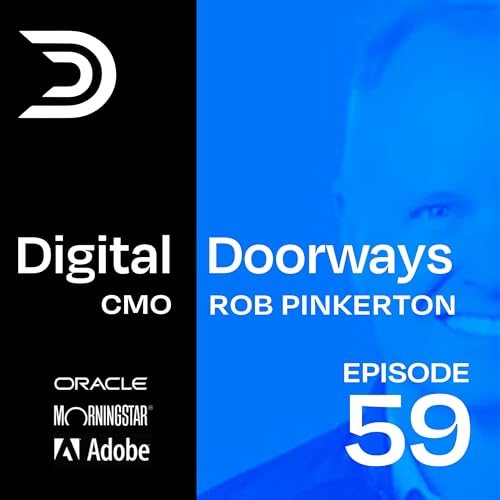Today on Digital Doorways, we’re doing something we’ve never done before: welcoming back our first-ever two-time guest. And it couldn’t be a more fitting milestone. When we launched this show, the mission was simple—explore how the world’s best leaders navigate change through brand, digital experience, and strategic clarity. Our very first guest was someone who embodies that mission: Rob Pinkerton, a marketer who’s spent his career operating at the hinge points where technology, data, and storytelling converge. From his days as CMO of Morningstar, where he modernized one of the most respected global financial brands, to his leadership shaping marketing at Oracle, Rob has consistently been the person companies call when they’re ready for their next leap forward.
Now, as he returns to the show, the timing couldn’t be better. CRM is undergoing its most significant transformation since the cloud era. AI, real-time data, privacy shifts, customer identity, and the blurring lines between product, marketing, and revenue are reshaping what growth even means. And Rob—someone who has lived inside both the enterprise giant and the innovation frontier—is uniquely positioned to decode where we go from here. Today, we’ll dive into the future of CRM, the evolution of marketing leadership, and what every brand must do to stay relevant as customer expectations accelerate. Let’s open the door, again, with the one and only Rob Pinkerton.
Questions include:
CRM as an Operating System
How do you see CRM evolving from a sales database into the operating system of the entire enterprise?
The End of “Static” Pipelines
With real-time data ingestion and predictive scoring becoming table stakes, what does the future sales pipeline actually look like?
The Next Marketing OS
Do you believe marketing teams will eventually run their workflows on a purpose-built “marketing OS” or will CRM platforms absorb that function?
First-Party Data Strategy
Given increasing privacy pressure, what are the most realistic ways brands can build durable first-party data without compromising trust?
Identity Resolution 2.0
What’s the next frontier in combining identity, intent, and behavioral data into a unified customer profile?
Buyer Journey Personalization
Is hyper-personalization overrated, or have we simply not executed it well yet?
CRM for Non-Traditional Industries
How will CRM need to evolve for sectors where buying cycles are long, complex, or high-risk like GovCon, defense tech, PE, or healthcare?
The New Role of CMOs
What core skills will CMOs need over the next five years that they don’t have today?
Signal vs. Noise
As marketers drown in dashboards, how should leaders distinguish actionable signals from vanity noise?
Influence of Product-Led Growth
How does PLG reshape the relationship between CRM, customer success, and marketing?
Content Intelligence
What role will AI-driven content intelligence play in shaping messaging, positioning, and campaign performance?
Brand Trust in a Data-Heavy World
Does increasing automation and data dependency dilute brand character, or can it enhance authenticity?
Lead Scoring Reinvented
Traditional lead scoring is broken. What will replace it?
Revenue Architecture
How should CEOs rethink revenue architecture when CRM becomes predictive instead of reactive?
Future of Account-Based Everything
Is ABM evolving into something entirely different, maybe account-based intelligence?
Marketing Attribution in a Post-Tracking Era
What’s the next realistic version of attribution once cookies, pixels, and cross-app tracking fade?
CRM for the 2030 Workforce
How will younger digital-native teams reshape CRM expectations, UI/UX, and workflows?
The CMO–CRO Alignment Gap
What systemic misalignments do you see between CMOs and CROs, and how should organizations bridge them?
AI-Enhanced Customer Experience
How will AI reshape the way brands design moments of surprise, delight, and brand loyalty?
 35 分
35 分 38 分
38 分 28 分
28 分 26 分
26 分 34 分
34 分 35 分
35 分 2025/09/1624 分
2025/09/1624 分 2025/09/1427 分
2025/09/1427 分
